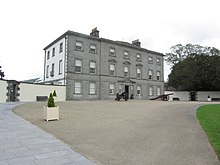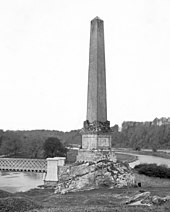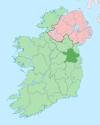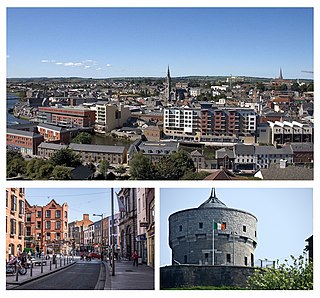
Drogheda is an industrial and port town in County Louth on the east coast of Ireland, 42 km (26 mi) north of Dublin city centre. It is located on the Dublin–Belfast corridor on the east coast of Ireland, mostly in County Louth but with the south fringes of the town in County Meath, 40 km (25 mi) north of Dublin city centre. Drogheda had a population of 44,135 inhabitants in 2022, making it the eleventh largest settlement by population in all of Ireland, and the largest town in the Republic of Ireland by both population and area. It is the last bridging point on the River Boyne before it enters the Irish Sea. The UNESCO World Heritage Site of Newgrange is located 8 km (5.0 mi) west of the town.

The Battle of the Boyne took place in 1690 between the forces of the deposed King James II, and those of King William III who, with his wife Queen Mary II, had acceded to the Crowns of England and Scotland in 1689. The battle was fought across the River Boyne close to the town of Drogheda in the Kingdom of Ireland, modern-day Republic of Ireland, and resulted in a victory for William. This turned the tide in James's failed attempt to regain the British crown and ultimately aided in ensuring the continued Protestant ascendancy in Ireland.
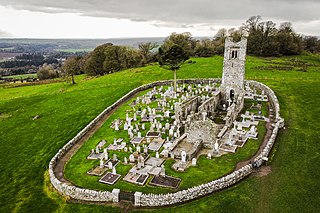
Slane is a village in County Meath, in Ireland. The village stands on a steep hillside on the left bank of the River Boyne at the intersection of the N2 and the N51. As of the 2022 census, Slane's population was 1,445. The village and surrounding area contains many historic sites dating back over 5,000 years. The village centre, as it is laid-out today, dates mainly from the 18th century. The village is in a townland and civil parish of the same name.

The River Boyne is a river in Leinster, Ireland, the course of which is about 112 kilometres (70 mi) long. It rises at Trinity Well, Newberry Hall, near Carbury, County Kildare, and flows towards the Northeast through County Meath to reach the Irish Sea between Mornington, County Meath, and Baltray, County Louth.
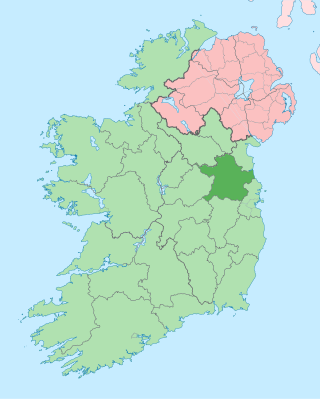
County Meath is a county in the Eastern and Midland Region of Ireland, within the province of Leinster. It is bordered by County Dublin to the southeast, Louth to the northeast, Kildare to the south, Offaly to the southwest, Westmeath to the west, Cavan to the northwest, and Monaghan to the north. To the east, Meath also borders the Irish Sea along a narrow strip between the rivers Boyne and Delvin, giving it the second shortest coastline of any county. Meath County Council is the local authority for the county.
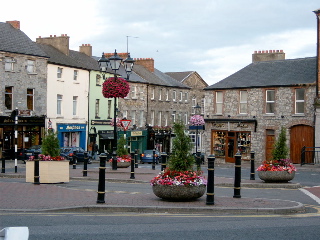
Navan is the county town and largest town of County Meath, Ireland. It is at the confluence of the River Boyne and Blackwater, around 50 km northwest of Dublin. At the 2022 census, it had a population of 33,886, making it the ninth largest settlement in Ireland. The town is in a civil parish of the same name.

Trim Castle is a castle on the south bank of the River Boyne in Trim, County Meath, Ireland, with an area of 30,000 m2. Over a period of 30 years, it was built by Hugh de Lacy and his son Walter as the caput of the Lordship of Meath. The Irish Government currently own and are in charge of the care of the castle, through the state agency The Office of Public Works (OPW).

Brú na Bóinne, also called the Boyne Valley tombs, is an ancient monument complex and ritual landscape in County Meath, Ireland, located in a bend of the River Boyne. It is one of the world's most important Neolithic landscapes, comprising at least ninety monuments including passage tombs, burial mounds, standing stones and enclosures. The site is dominated by the passage tombs of Newgrange, Knowth and Dowth, built during the 32nd century BC. Together these have the largest assemblage of megalithic art in Europe. The associated archaeological culture is called the "Boyne culture".

The Brú na Bóinne Visitor Centre is the starting point for all visits to the monuments of the UNESCO World Heritage Site at Brú na Bóinne, notably the passage graves of Newgrange and Knowth. It is located eight kilometers west of Drogheda in County Meath, Ireland.

Tullyallen is a village, civil parish and townland 6 km north-west of the town of Drogheda in County Louth, Ireland. It is in the historic Barony of Ferrard. It is located in the historical Boyne Valley, in the Catholic parish of Mellifont ; it is also close to Newgrange, Knowth and Dowth burial mounds, Monasterboice monastery, and to the Battle of the Boyne site.

The Boyne Navigation is a series of canals running 31 km (19 mi) roughly parallel to the River Boyne from Oldbridge to Navan in County Meath, in Ireland. The navigation was once used by horse-drawn boats travelling between Navan, Slane and the port of Drogheda; however is now derelict. The Boyne Navigation branch of the Inland Waterways Association of Ireland have an agreement with An Taisce – The National Trust for Ireland giving it a license to carry out restoration work on the navigation to return it to a usable waterway.

Mornington is a coastal village on the estuary of the River Boyne in County Meath, Ireland approximately 5 km downriver from the centre of Drogheda. Together with the neighbouring villages of Laytown, Bettystown and Donacarney, it comprises the urban area of Laytown–Bettystown–Mornington–Donacarney with a combined population of 15,642 at the 2022 census.
Monard is a largely rural townland in the civil parish of Whitechurch to the north-west of Cork City in Ireland.

Donore, historically Dunower, is a small village in County Meath, Ireland. It lies near Drogheda on the border between County Meath and County Louth, in the Boyne Valley on the road between Drogheda and the Brú na Bóinne heritage site. The village is in a civil parish of the same name.

Rossnaree or Rosnaree is a small village and townland in County Meath, Ireland, 10 km west of Drogheda. The village is on the south bank of the River Boyne, and the Brú na Bóinne complex of neolithic monuments is nearby, on the north bank of the Boyne. Rossnaree commands a ford that was used by the Williamites at the Battle of the Boyne in 1690. The walls of the mill at Rossnaree once contained a Sheela na Gig, although this has been removed for safekeeping and is in private possession.
The Boyne Greenway or Boyneside Trail is a greenway, cycle track and walkway along the Oldbridge section of the Boyne Navigation in Ireland. It runs from Pass, County Meath to opposite the entrance to the 'Battle of the Boyne' Visitor Centre.

Athcarne Castle is a ruined Elizabethan castle outside the town of Duleek in County Meath, Ireland.
The Yellow River is a river in central Ireland, a tributary of the River Boyne.
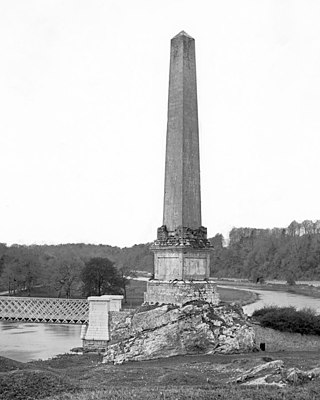
The Boyne Obelisk, also known as King William's Obelisk, was an obelisk located in Oldbridge, near Drogheda, County Louth, Ireland.

The Mattock River is a river in Ireland. It is a tributary of the River Boyne.

